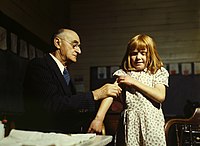
Photo from wikipedia
Hidden populations, such as injecting drug users (IDUs), sex workers (SWs) and men who have sex with men (MSM), are considered at high risk of contracting and transmitting infectious diseases… Click to show full abstract
Hidden populations, such as injecting drug users (IDUs), sex workers (SWs) and men who have sex with men (MSM), are considered at high risk of contracting and transmitting infectious diseases such as AIDS, gonorrhea, syphilis etc. However, public health interventions to such groups are prohibited due to strong privacy concerns and lack of global information, which is a necessity for traditional strategies such as targeted immunization and acquaintance immunization. In this study, we introduce an innovative intervention strategy to be used in combination with a sampling approach that is widely used for hidden populations, Respondent-driven Sampling (RDS). The RDS strategy is implemented in two steps: First, RDS is used to estimate the average degree (personal network size) and degree distribution of the target population with sample data. Second, a cut-off threshold is calculated and used to screen the respondents to be immunized. Simulations on model networks and real-world networks reveal that the efficiency of the RDS strategy is close to that of the targeted strategy. As the new strategy can be implemented with the RDS sampling process, it provides a cost-efficient and feasible approach for disease intervention and control for hidden populations.
Journal Title: Scientific Reports
Year Published: 2017
Link to full text (if available)
Share on Social Media: Sign Up to like & get
recommendations!